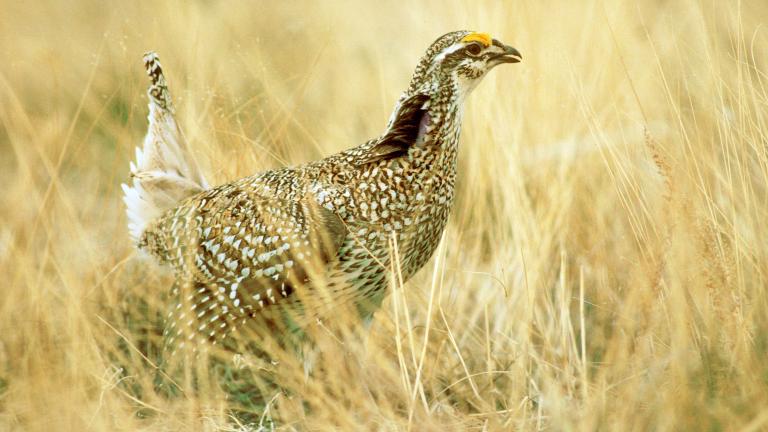Plains Sharp-Tailed Grouse
A large grouse with spectacular mating displays where the males show off with purple air sacs on their neck.

About This Species
The plains sharp-tailed grouse is a bird of Colorado's eastern grasslands. Sharp-tailed grouse can be differentiated from greater prairie chickens by their overall brown and whitish appearance, a distinctly pointed tail visible when standing or in flight, and brown V's against the white background on the breast. Male plains sharp-tailed grouse exhibit purple air sacs on their necks during breeding season.
More Information:
Physical Characteristics
Birds are 15 to 20 inches in length.
Range
They are resident from Alaska east to Hudson Bay and south to Utah. They are relatively common residents of Montana, North and South Dakota, and Nebraska and range as far east as Michigan. In Colorado, plains sharp-tailed grouse formerly nested over much of the northern two-thirds of the eastern prairie, but are currently known to occur primarily in northern and central Weld County, with small numbers of grouse also found in northern Logan and (occasionally) Sedgwick counties.
Habitat
Currently, plains sharp-tailed grouse are found almost exclusively in Conservation Reserve Program (CRP) grasslands in Colorado. Typically, the plains grouse occupies medium to tall grasslands for nesting, loafing and night-roosting cover. Similar to other plains grouse species, courtship activities occur at lek sites, which are characterized by relatively short vegetation and are highly visible to surrounding habitats. Plains sharp-tailed grouse use shrubs heavily when available, for both cover and as a food source. Flowering plants provide an important part of habitat during the summer brooding period.
Diet
Diets include a variety of forb seeds, waste grain, and leafy green vegetation. In winter, sharp-tailed grouse also feed on buds and catkins of deciduous trees or shrubs and berries. Chicks consume insects almost exclusively for several weeks after hatching.
Reproduction
During the breeding season in March to June, sharp-tailed males congregate on specific areas known as dancing grounds, or leks, in the early morning to attract nearby female grouse. The male performs a dance in which the wings are extended, the tail is raised vertically, the head is lowered and the entire body is horizontal to the ground. The bird's feet move rapidly and the tail feathers make a clicking noise. As an invitation to the females, the sharp-tailed male cackles loudly and jumps three to four feet in the air rapidly beating its wings. This display is called the "flutter-jump."
Females lay typically 10 to 13 buff-brown eggs in a grass-lined depression in tall grass or brush.